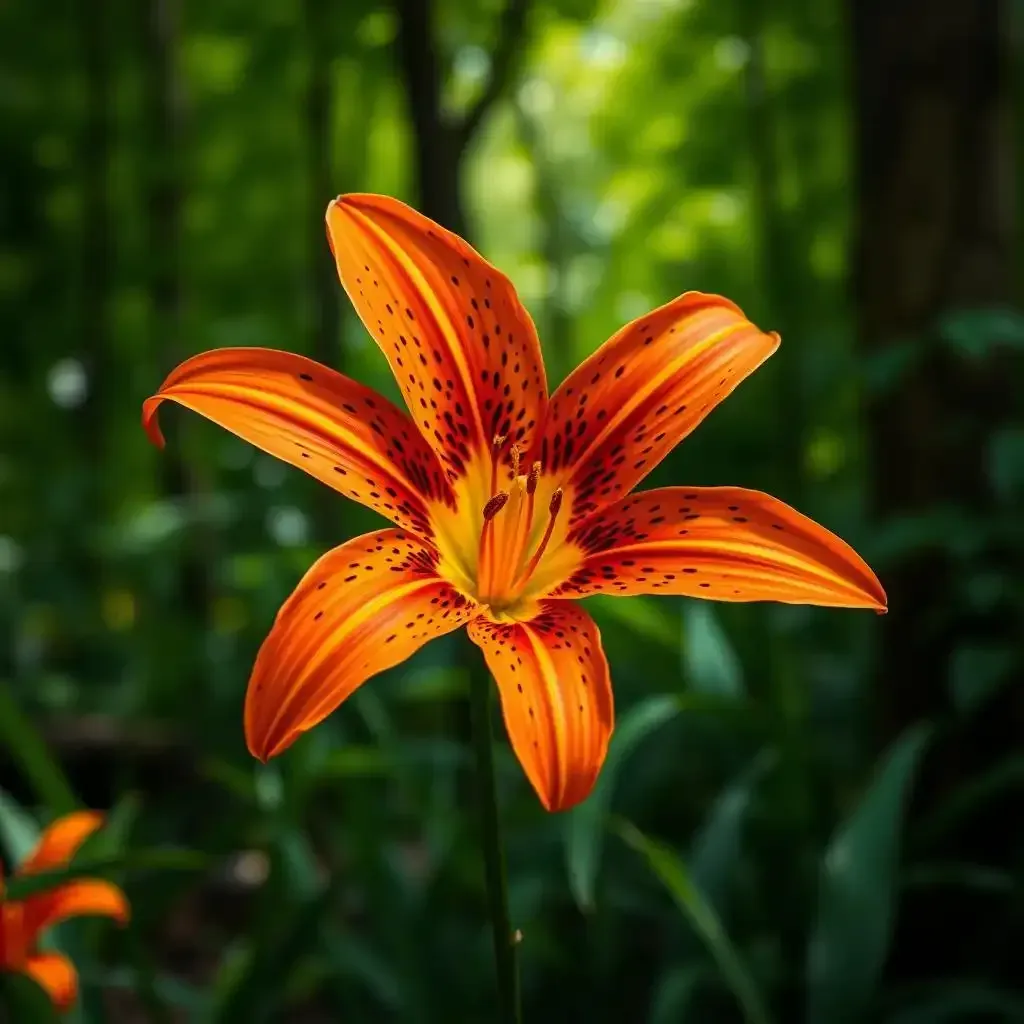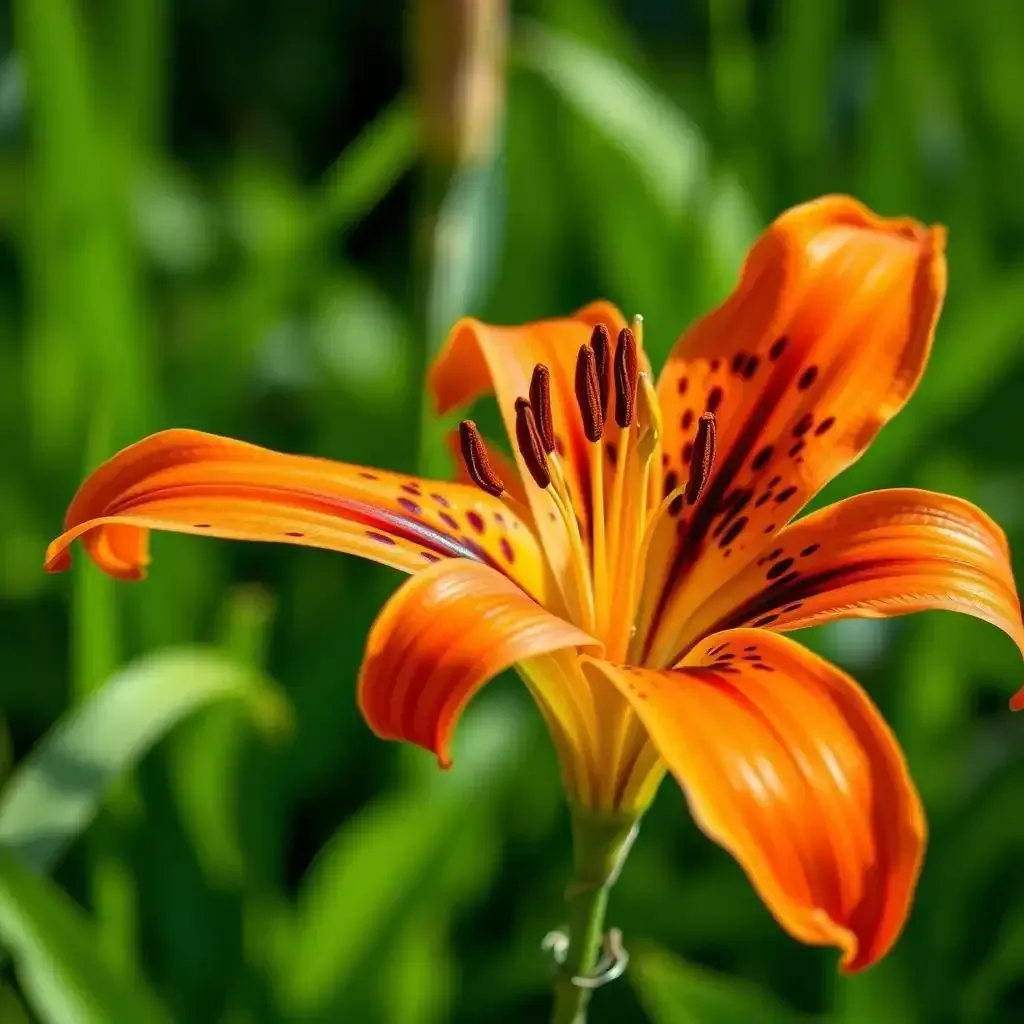Table of Contents
Hey there, plant lovers! Ever gazed upon a Tiger Lily and felt a jolt of fiery energy? These aren't your grandma's lilies; they're bold, striking, and packed with interesting facts. At lilyflower.homes, we’re diving headfirst into the captivating world of the Tiger Lily, uncovering everything from its scientific name (Lilium lancifolium, in case you were wondering) to its surprising toxicity. We'll explore where these beauties originate, what they symbolize, and how to keep them thriving in your garden. Get ready to be amazed by the surprising world of tiger lily flower facts, because these aren't your average garden flowers. Prepare for a process filled with vibrant colors, intriguing history, and practical tips to ensure your Tiger Lilies flourish. This article will cover the basics of Tiger Lily identification, their native habitats, cultural significance, and essential care instructions. So, let's get started and open up the secrets of these magnificent flowers!

Amazing Tiger Lily Flower Facts: Ultimate Guide
Tiger Lily Flower Facts: Introducing the Secrets of this Striking Bloom

Tiger Lily Flower Facts Introducing The Secrets Of This Striking Bloom
Hey there, fellow flower enthusiasts! Let's talk Tiger Lilies – those fiery, spotted beauties that practically scream "look at me!" I've been researching these amazing plants, and I'm bursting with excitement to share what I've learned. They're not just pretty faces; there's a whole fascinating story behind each bloom. Did you know, for example, that their scientific name is Lilium lancifolium? Sounds fancy, right? But it's just the beginning of their amazing story.
First things first: those striking orange petals, dusted with dark spots – they're like tiny tiger stripes on a flower! This is where they get their name, naturally. And those spots aren't just for looks. They're actually a clever way to attract pollinators like bees and butterflies. Want to learn how to draw one? Check out our guide on drawing tiger lilies!
Feature | Description |
|---|---|
Color | Typically fiery orange with dark spots |
Height | Can reach up to 5 feet tall! |
Origin | Native to parts of Asia, including Japan, China, and Korea |
But here's a fun fact that might surprise you: Tiger Lilies are actually pretty unique in how they spread their seeds. Instead of relying on their seeds to spread, they can actually produce tiny bulblets along their stems. These bulblets drop off and grow into new plants. Pretty clever, huh? It’s like they have their own tiny little lily-clones!
And speaking of unique, let's talk about their symbolism. In many cultures, Tiger Lilies represent wealth, prosperity, and good fortune. Their vibrant color is often associated with passion, energy, and boldness. It's no wonder they're such a popular choice for gardens and flower arrangements. Want to know more about if they're poisonous? Find out more on tiger lily toxicity!
- Vibrant orange color
- Dark spots on petals
- Unique bulblet propagation
- Symbol of wealth and prosperity
I've just scratched the surface of what makes Tiger Lilies so special. In the next sections, we'll explore their native habitats, their cultural significance, and how to give them the best care possible so they can thrive in your own garden. Get ready to be amazed by the amazing world of tiger lilies!
Tiger Lily Flower Facts: A Deep Explore into its Native Habitats and Cultivation
Where in the World are Tiger Lilies Found?
Hey there, fellow plant nerds! Let's talk about where these amazing tiger lilies actually come from. They're not just popping up everywhere; they have specific homes they prefer. Turns out, tiger lilies are originally from Asia – think Japan, China, and Korea. Imagine these vibrant orange flowers brightening up those landscapes! It's pretty cool to think about how far they've traveled to become so popular around the world. They're like little orange adventurers, spreading their beauty wherever they can.
But they're not just any old lilies. They're super adaptable! You can find them growing happily in ditches and fields, proving they're tougher than they look. They're like the tough kids on the playground who can handle anything! If you're lucky enough to have a garden, you can even grow them yourself. It's a fun project and super rewarding. Want to learn more about the best places to plant them? Check out our guide on soil needs for tiger lilies!
Country | Habitat | Notes |
|---|---|---|
Japan | Moist meadows and woodlands | Often found near water sources |
China | Mountain slopes and valleys | Adaptable to various altitudes |
Korea | Disturbed areas and roadsides | Resilient and thrives even in less-than-ideal conditions |
Growing Your Own Tiger Lily Paradise
So you want to grow your own tiger lilies? That's awesome! It's a little like having your own tiny, orange jungle right in your backyard. It's super rewarding, and you get to enjoy their beauty all season long. But before you get started, remember that these are not delicate darlings. They're tough cookies who can handle a bit of neglect, but they still need the right conditions to truly thrive. Think of it like this: they're like little orange lions – majestic, bold, but they still need their proper environment to roar with their full beauty!
First, make sure you have a spot with plenty of sun. They love soaking up those rays! Think of them as tiny little solar panels, turning sunlight into gorgeous blooms. Also, make sure the soil is well-drained – no soggy feet for these lilies! Water them regularly, but not too much. Overwatering is like giving them too many hugs – a bit too much attention can be a bad thing. And don’t forget the fertilizer! It's like giving them a delicious energy drink to help them bloom their best. If you're unsure about the specifics, we have a detailed guide on fertilizing lilies to help you.
- Plenty of sunlight
- Well-drained soil
- Regular watering (but not too much!)
- Fertilizer for extra oomph
Exploring the Symbolism and Cultural Significance of Tiger Lily Flower Facts
Okay, so we've talked about where tiger lilies come from and how to grow them, but let's get into the really fun stuff: what they *mean*. It's not just a pretty flower; it's a walking, talking symbol! In many Asian cultures, the tiger lily is linked to wealth and good luck. Imagine a tiny, fiery orange dragon guarding your treasure – that's kind of the vibe. Its bright color is all about energy and passion – it’s like a little burst of sunshine in your garden! I’ve even seen them used in art and traditional celebrations. They’re a bit like a tiny, orange firework, exploding with meaning.
But it's not just about wealth. For some, the tiger lily represents strength and resilience. Think about it – these lil' guys can grow almost anywhere! They're tough, adaptable, and full of life. They're like the scrappy underdog in a flower-ability competition. They don't need a lot of fuss to thrive, just some sunshine and well-drained soil.Want to learn more about growing them? Check out our guide on for tiger lilies!
- Wealth and prosperity
- Good fortune and luck
- Strength and resilience
- Passion and energy
And, get this, the tiger lily's symbolism can even vary depending on the culture. It's like a secret code only certain people understand! Some people see them as a symbol of love and devotion; others see them as representations of motherly love. It's all pretty fascinating stuff, isn't it? It's like the flower has a secret language, and we're just starting to learn how to speak it. For more on the symbolism of flowers, check out flowers similar to tiger lilies!
I've always been captivated by how different cultures see the same thing. It makes me wonder what other hidden meanings are out there, waiting to be discovered. Maybe each tiny spot on a tiger lily petal holds a secret message! What do *you* think the tiger lily symbolizes? Let me know in the comments!
Culture | Symbolism | Meaning |
|---|---|---|
Japan | Wealth, prosperity | Good fortune, abundance |
China | Resilience, strength | Overcoming challenges, endurance |
Korea | Love, devotion | Deep affection, commitment |
Tiger Lily Flower Facts: Caring for Your Tiger Lilies and Addressing Common Issues

Tiger Lily Flower Facts Caring For Your Tiger Lilies And Addressing Common Issues
Giving Your Tiger Lilies the Royal Treatment
So, you've got your gorgeous tiger lilies, and you want them to thrive, right? Think of it like this: they're like little orange royalty, demanding just the right kind of pampering. First off, sunlight! These aren't shy violets; they need at least six hours of sunshine a day. Imagine them basking in the sun, soaking up all that glorious energy, turning it into those amazing blooms. A sunny spot is key! Don't forget the water, either – they like it consistently moist, but not soggy. Think of it like Goldilocks and the Three Bears – not too wet, not too dry, just right! Too much water, and their roots will get grumpy, leading to rot. Too little, and they'll wilt like a sad clown. Consistent moisture is the golden rule. Need help with watering? Check out our guide on watering lilies.
- Sunlight: At least 6 hours a day!
- Watering: Keep consistently moist, but not waterlogged.
- Soil: Well-drained soil is crucial.
Troubleshooting Your Tiger Lily Troubles
Even with the best care, sometimes things go sideways. Maybe your lilies are looking a little droopy, or maybe they're not blooming as much as you'd like. Don't panic! It's like a detective story – you need to find the clues to solve the mystery. Are the leaves yellowing? That could be a sign of overwatering or poor drainage. Check your soil and adjust your watering accordingly. Are they not blooming? They might need more fertilizer or sunlight. Remember, they're like little orange suns, needing plenty of energy to create their vibrant blooms. Need a hand with fertilizer? Check out our !
Problem | Possible Cause | Solution |
|---|---|---|
Yellowing Leaves | Overwatering, poor drainage | Improve drainage, adjust watering |
Lack of Blooms | Insufficient sunlight, lack of fertilizer | Increase sunlight exposure, fertilize appropriately |
Pests | Aphids, spider mites | Use appropriate pest control methods (see our pest control guide!) |
Final Thought
So there you have it – a whirlwind tour of Tiger Lily flower facts! From their vibrant orange hues and speckled petals to their surprising toxicity and rich symbolism, these lilies are far more fascinating than you might think. Remember, while they might bring good fortune and prosperity to your garden, they need a little TLC to truly flourish. Happy gardening, and may your Tiger Lilies bring you joy for years to come!